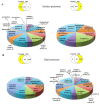HIV-1 and Amyloid Beta Remodel Proteome of Brain Endothelial Extracellular Vesicles
- PMID: 32326569
- PMCID: PMC7215366
- DOI: 10.3390/ijms21082741
HIV-1 and Amyloid Beta Remodel Proteome of Brain Endothelial Extracellular Vesicles
Abstract
Amyloid beta (Aβ) depositions are more abundant in HIV-infected brains. The blood-brain barrier, with its backbone created by endothelial cells, is assumed to be a core player in Aβ homeostasis and may contribute to Aβ accumulation in the brain. Exposure to HIV increases shedding of extracellular vesicles (EVs) from human brain endothelial cells and alters EV-Aβ levels. EVs carrying various cargo molecules, including a complex set of proteins, can profoundly affect the biology of surrounding neurovascular unit cells. In the current study, we sought to examine how exposure to HIV, alone or together with Aβ, affects the surface and total proteomic landscape of brain endothelial EVs. By using this unbiased approach, we gained an unprecedented, high-resolution insight into these changes. Our data suggest that HIV and Aβ profoundly remodel the proteome of brain endothelial EVs, altering the pathway networks and functional interactions among proteins. These events may contribute to the EV-mediated amyloid pathology in the HIV-infected brain and may be relevant to HIV-1-associated neurocognitive disorders.
Keywords: HIV-1; amyloid beta; blood–brain barrier; extracellular vesicles.
Conflict of interest statement
The authors declare no conflicts of interest.
Figures









References
MeSH terms
Substances
Grants and funding
LinkOut - more resources
Full Text Sources
Medical

